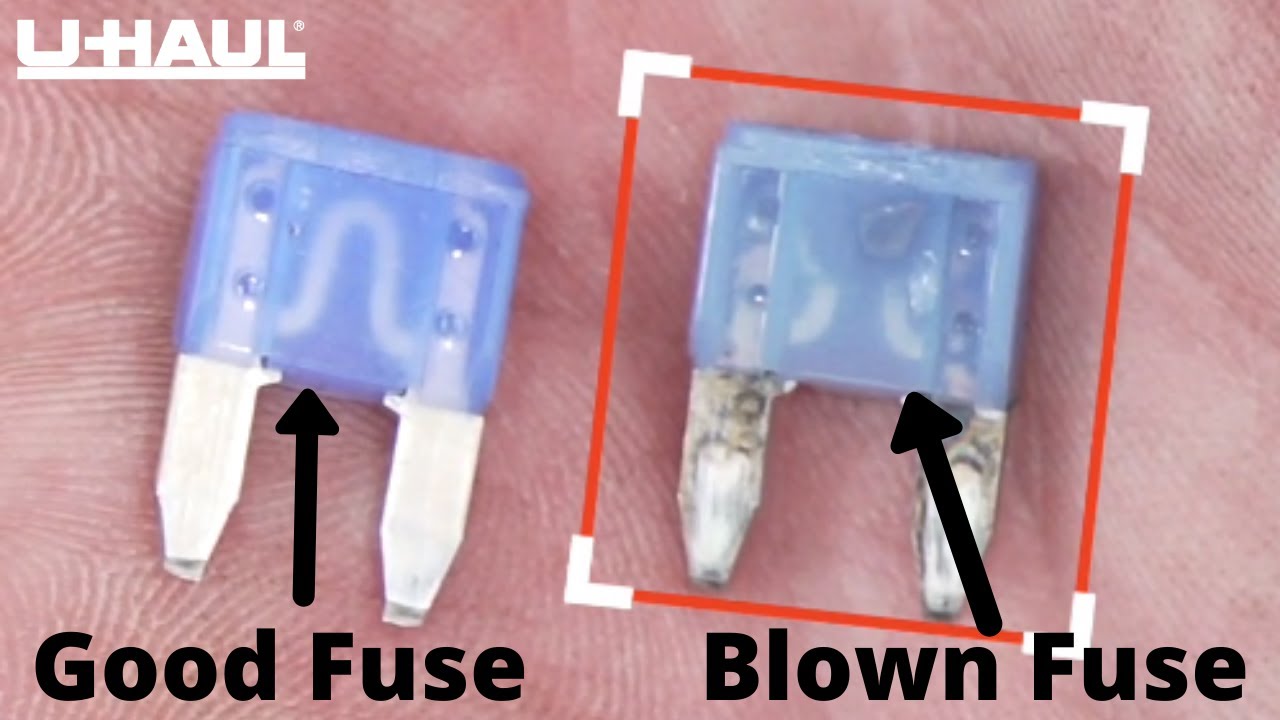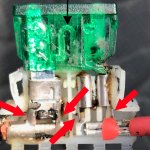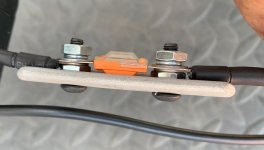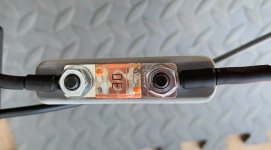rick_p
100 W
There's two parts to this issue, part one is a crash that damaged the hub motor cable, and part two is the discovery of a near melt down by the battery, which may have been caused by the crash, but might just be coincidence.
Part 1:
On my commute home a driver cut me off, which caused me to go down. Thankfully I wasn't going fast, but the bike went down on the left side and caused minor damage to the cable that goes into the rear wheel hub motor. I did a brief road side inspection and didn't see anything that looked overly concerning so I rode home, and the bike operated normally.
For whatever reason, the wheel didn't come with one of those plastic covers to protect where the cable enters the axle, so I had wrapped it up with electrical tape, which I didn't remove when I did the road side inspection because it actually looked like it helped protect the cable. When I got home I removed the tape and the thin spring thing meant to protect the cable. You could now see that the cable incurred a minor pinch (it was no longer perfectly round), and there was a small tear in the cable's sheathing. Here is a picture:
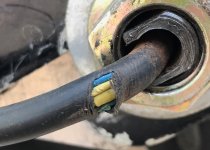
Part 2:
When I saw the tear in the sheathing, but didn't find any significant damage to the internal wires that I could see (yes, I see there is a tiny exposure on the small yellow wire, but it's the only one, the other scratches don''t expose any wires) I thought the best way to protect this would be to put on a layer or two of shrink wrap and then fabricate a protective bracket to prevent future damage.
So, to get that going I needed to free the other end of that cable from the controller, and I thought it best to remove the battery before I do anything. That is when I noticed some solder had come out of the shrink wrap covering a soldered connection next to the fuse. Oh no I thought!!!!
I thought!!!!
This is where I need your help. My first thought was there was a brief short circuit when the hub cable got pinched, but then the more I thought about it I realized, wait, this is where the battery power is going into the controller, if there was a short circuit at the hub cable, the melt down (arcing) would have occurred right there at the pinch location, and it would have melted the wire sheathing and it would be noticiable.
So what happened here then? Is this just coincidence and I'm darn lucky to have noticed it before a lot worse happened? Let's take a closer look...
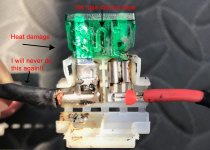
I will never put a solder joint so close to a fuse again, the melted solder could have gotten inside the fuse holder and caused a bridge across the fuse!!!
A bridge did not occur, and clearly it got hot enough to melt solder, yet the fuse never blew. What the heck!!!
Possible clue - I recently changed the front chainring (46 teeth -> 52 teeth) so I could increase my cruising speed. With the smaller sprocket I was peddling too fast, so my top cruising speed was 20mph, with the new sprocket I was able to maintain 24mph and the pedal cadence was just right. Is it possible that the increased speed over long duration pulled too much amperage from the battery and that is what caused the wire to get so hot? Or, do you think the crash had something to do with it? Or, am I overlooking something else??
Thanks in advance for your thoughts on this.
Part 1:
On my commute home a driver cut me off, which caused me to go down. Thankfully I wasn't going fast, but the bike went down on the left side and caused minor damage to the cable that goes into the rear wheel hub motor. I did a brief road side inspection and didn't see anything that looked overly concerning so I rode home, and the bike operated normally.
For whatever reason, the wheel didn't come with one of those plastic covers to protect where the cable enters the axle, so I had wrapped it up with electrical tape, which I didn't remove when I did the road side inspection because it actually looked like it helped protect the cable. When I got home I removed the tape and the thin spring thing meant to protect the cable. You could now see that the cable incurred a minor pinch (it was no longer perfectly round), and there was a small tear in the cable's sheathing. Here is a picture:

Part 2:
When I saw the tear in the sheathing, but didn't find any significant damage to the internal wires that I could see (yes, I see there is a tiny exposure on the small yellow wire, but it's the only one, the other scratches don''t expose any wires) I thought the best way to protect this would be to put on a layer or two of shrink wrap and then fabricate a protective bracket to prevent future damage.
So, to get that going I needed to free the other end of that cable from the controller, and I thought it best to remove the battery before I do anything. That is when I noticed some solder had come out of the shrink wrap covering a soldered connection next to the fuse. Oh no
This is where I need your help. My first thought was there was a brief short circuit when the hub cable got pinched, but then the more I thought about it I realized, wait, this is where the battery power is going into the controller, if there was a short circuit at the hub cable, the melt down (arcing) would have occurred right there at the pinch location, and it would have melted the wire sheathing and it would be noticiable.
So what happened here then? Is this just coincidence and I'm darn lucky to have noticed it before a lot worse happened? Let's take a closer look...

I will never put a solder joint so close to a fuse again, the melted solder could have gotten inside the fuse holder and caused a bridge across the fuse!!!
A bridge did not occur, and clearly it got hot enough to melt solder, yet the fuse never blew. What the heck!!!
Possible clue - I recently changed the front chainring (46 teeth -> 52 teeth) so I could increase my cruising speed. With the smaller sprocket I was peddling too fast, so my top cruising speed was 20mph, with the new sprocket I was able to maintain 24mph and the pedal cadence was just right. Is it possible that the increased speed over long duration pulled too much amperage from the battery and that is what caused the wire to get so hot? Or, do you think the crash had something to do with it? Or, am I overlooking something else??
Thanks in advance for your thoughts on this.



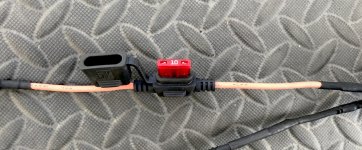
![Screenshot_20220718-193636[1].png Screenshot_20220718-193636[1].png](https://endless-sphere.com/sphere/data/attachments/183/183259-7085ab247e5e59bf452c24b8f11eb5de.jpg)
